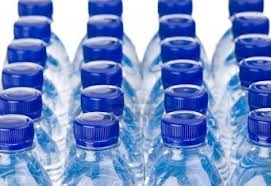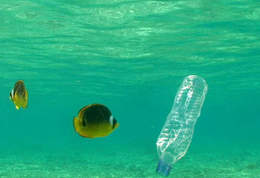By JOHN FLESHER, AP Environmental Writer | July 29, 2013 | posted in the Houston Chronicle

Photo By Courtesy 5gyres.org, Carolyn Box
In
this 2012 photo provided by 5gyres.org is a sample collected in eastern
Lake Erie showing tiny bits of plastic on a penny. Scientists
discovered masses of floating plastic particles in Lakes Superior, Huron
and Erie last year. This summer, they’re widening the search to Lakes
Michigan and Ontario. They are trying to determine whether fish are
eating the particles, which may come from city wastewater, and passing
them up the food chain to humans.
Scientists who have studied gigantic masses of floating plastic in the world's oceans are now reporting similar discoveries in the lakes that make up nearly one-fifth of the world's fresh water. They retrieved the particles from Lakes Superior, Huron and Erie last year. This summer, they're widening the search to Lakes Michigan and Ontario, skimming the surface with finely meshed netting dragged behind sailing vessels.
"If you're out boating in the Great Lakes, you're not going to see large islands of plastic," said Sherri Mason, a chemist with State University of New York at Fredonia and one of the project leaders. "But all these bits of plastic are out there."
Experts say it's unclear how long "microplastic" pollution has been in the lakes or how it is affecting the environment. Studies are under way to determine whether fish are eating the particles.
The newly identified hazard is the latest of many for a Great Lakes fish population that has been hammered by natural enemies like the parasitic sea lamprey, which nearly wiped out lake trout, and man-made contamination. Through it all, the fishing industry remains a pillar of the region's tourist economy. Until the research is completed, it won't be clear whether the pollution will affect fishing guidelines, the use of certain plastics or cities that discharge treated wastewater into the lakes.
Scientists have already made a couple startling finds. The sheer number of plastic specks in some samples hauled from Lake Erie, the shallowest and smallest by volume, were higher than in comparable samples taken in the oceans.
Also, while it's unknown where the ocean plastic came from, microscopic examination of Great Lakes samples has produced a smoking gun: many particles are perfectly round pellets. The scientists suspect they are abrasive "micro beads" used in personal care products such as facial and body washes and toothpaste.
They're so minuscule that they flow through screens at waste treatment plants and wind up in the lakes, said Lorena Rios Mendoza, a chemist with the University of Wisconsin-Superior. At the urging of scientists and advocates, some big companies have agreed to phase them out.
During a meeting of the American Chemical Society in April, Rios reported the team had collected up to 1.7 million tiny particles last year in Lake Erie, which acts as something of a "sink" because it receives the outflow from the three lakes to the north — Superior, Michigan and Huron.
Mason said preliminary samples indicate "Lake Ontario is as contaminated as Lake Erie, if not more so."
The Great Lakes are no stranger to ecological calamity. Zebra and quagga mussels have destabilized food chains, and ravenous Asian carp are poised to invade. Runaway algae blooms that had been stamped out a generation ago have returned. Dozens of harbors and river mouths are fouled with toxic waste.
Now, researchers are stepping up efforts to determine how much damage the plastic could do. Mason and Rios are working with the 5 Gyres Institute, a nonprofit group based in Los Angeles that has called attention to sprawling masses of plastic in the oceans.
While Mason searches Lake Michigan for more plastic, Rios is poking through fish innards for plastic fragments. In ocean environments, fish and birds are known to feed on microplastics, apparently mistaking them for fish eggs.
A more complicated question is whether the particles are soaking up toxins in the water, potentially contaminating fish that eat them — and sending them up the food chain.
Rios said lab examination had detected two potentially harmful compounds in the Lake Erie plastic debris: PAHs, which are created during incineration of coal or oil products; and PCBs, which were used in electrical transformers and hydraulic systems before they were banned in 1979. Both are capable of causing cancer and birth defects.
Everyone agrees the best way to avoid environmental damage from plastics is to keep them out of the water in the first place. Eriksen's group has urged makers of personal care products to stop using microbeads. Procter & Gamble and Johnson & Johnson have announced phaseout plans. L'Oreal says it won't develop new products with microbeads.
For anglers who regularly feast on salmon, perch and other delicacies from the lakes' depths, the most common reaction to the microplastic scare is a resigned shrug. They're used to warnings against overindulging on fish because of mercury, PCBs and other contaminants.
"I think people aren't going to be really worried about it until more research is done to see just what we're dealing with," said Ron Dohm, president of the Grand Traverse Area Sport Fishing Association in northern Michigan. "You look in the waters and you see all those cigarette butts — the fish eat them, too."
___
Follow John Flesher on Twitter at http://twitter.com/JohnFlesher


 I
remember the first time I saw a bottle of water for sale, thinking it
was the most ridiculous thing I'd ever encountered. Who the heck would
actually PAY to drink water when they could get it for free at home?
That's just crazy! I drank out of the faucet every single day, or the
garden hose in a pinch, and there was obviously nothing wrong with me
(other than mentally).
I
remember the first time I saw a bottle of water for sale, thinking it
was the most ridiculous thing I'd ever encountered. Who the heck would
actually PAY to drink water when they could get it for free at home?
That's just crazy! I drank out of the faucet every single day, or the
garden hose in a pinch, and there was obviously nothing wrong with me
(other than mentally).
 What is the ripple effect?
What is the ripple effect?

